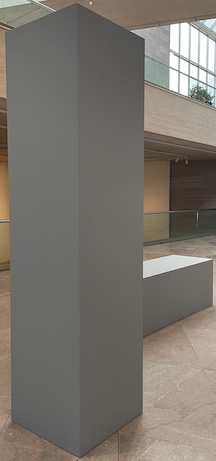Robert Morris (artist) facts for kids
Quick facts for kids
Robert Morris
|
|
|---|---|
| Born | February 9, 1931 Kansas City, Missouri, U.S.
|
| Died | November 28, 2018 (aged 87) Kingston, New York, U.S.
|
| Education | University of Kansas, Kansas City Art Institute, Reed College, Hunter College |
| Known for | Sculpture |
| Movement | Minimalism |
| Spouse(s) | Simone Forti (1955-1962) Priscilla Johnson Lucile Michels |
Robert Morris (February 9, 1931 – November 28, 2018) was an American artist. He was a sculptor, a conceptual artist, and a writer. He is known as one of the most important thinkers behind Minimalism. He also greatly helped develop performance art, land art, and installation art. Morris lived and worked in New York for most of his life.
Contents
Early Life and Education
Robert Morris was born in Kansas City, Missouri. His parents were Robert O. Morris and Lora "Pearl" Schrock Morris. From 1948 to 1950, he studied engineering at the University of Kansas. He also studied art at the University of Kansas and the Kansas City Art Institute. He studied philosophy at Reed College.
In 1951 and 1952, he paused his studies. He served in the United States Army Corps of Engineers in Arizona and Korea. In 1955, he married dancer Simone Forti. They later divorced in 1962. In 1959, he moved to New York City. There, he studied sculpture. He earned a master's degree in art history in 1963 from Hunter College.
His Art Work

Morris first started as a painter. His art in the 1950s was inspired by Abstract Expressionism. This style was especially seen in the work of Jackson Pollock. While living in California, Morris met artists like La Monte Young and John Cage. He also worked with Warner Jepson and his first wife, Simone Forti.
Morris became interested in dance and choreography. He believed that making art was like a performance by the artist. In the 1950s, he explored dance while living in San Francisco with Simone Forti. Morris moved to New York City in 1960. In 1962, he created a performance called Column. This piece explored how bodies move in space. A tall square column stood on stage for a few minutes, then fell over.
In New York City, Morris began to study the work of Marcel Duchamp. He made conceptual art pieces. These included Box with the Sound of its Own Making (1961) and Fountain (1963). In 1963, he showed his Minimalist sculptures at the Green Gallery in New York. The next year, he showed large shapes made from wood. These were called polyhedron forms.
In 1964, Morris created two famous performance artworks. One was 21.3, where he lip-synced to an essay. The other was Site with Carolee Schneemann. In 1966, he wrote important essays called "Notes on Sculpture" in Artforum magazine. He showed two L Beams in a key 1966 art show. This show was called "Primary Structures" at the Jewish Museum in New York.
In 1967, Morris made Steam, an early example of Land Art. By the late 1960s, his work was shown in museums. His art became very large. It often filled most of the gallery space. He used modular units or piles of earth and felt. For example, Untitled (Pink Felt) (1970) has many pieces of pink industrial felt. These pieces are simply dropped onto the floor. In 1971, Morris designed an exhibition for the Tate Gallery. It filled the entire central sculpture gallery with ramps and cubes.
He also created the Robert Morris Observatory in the Netherlands. This is like a "modern Stonehenge." It helps identify the solstices and the equinoxes.
In the late 1970s, Morris changed his style. He started making art that showed figures. This change surprised many people who liked his earlier work. His art during this time often explored serious themes.
In 2002, Morris designed seventeen stained-glass windows. These were for the medieval Maguelone Cathedral in France. The windows show the ripples of a pebble dropped in water. They were placed in the restored Romanesque window openings.
Morris's last exhibition was "Banners and Curses." It was on display at the Leo Castelli Gallery in New York City. He attended the opening night reception for the show.
Death
Robert Morris died on November 28, 2018. He passed away in Kingston, New York, from pneumonia. He was 87 years old. He had married Lucile Michels in 1984. He is survived by his wife, Lucile, and his daughter, Laura Morris.
Artist Books
- Hurting Horses, 64 pages, 23,5 x 16,5 cm. A special edition of 1500 copies. Published in 2005 by mfc-michèle didier.
His Writings
- Continuous Project Altered Daily: The Writings of Robert Morris, October Books, MIT Press [1]
- 'Notes on Sculpture [2]
Exhibitions
Morris's first art show was in 1958 at the Dilexi Gallery in San Francisco. Many museums have shown his art by himself. These include the Whitney Museum of American Art in New York (1970) and the Art Institute of Chicago (1980). Other museums include the Museum of Contemporary Art, Chicago and the Newport Harbor Art Museum (1986). The Corcoran Gallery of Art in Washington, D.C., also hosted a show (1990).
In 1994, the Solomon R. Guggenheim Museum in New York held a big show. It was called Robert Morris: The Mind/Body Problem. This show then traveled to Germany and France.
Notable Works
- Box with the Sound of Its Own Making (1961), Seattle Art Museum
- Steam Work for Bellingham-II (1974), Western Washington University Public Sculpture Collection, Bellingham, Washington
- Untitled (L-Beams) (1965), Whitney Museum of American Art, New York
- Labyrinth, 1982 Gori Collection, Italy
See Also
 In Spanish: Robert Morris (artista) para niños
In Spanish: Robert Morris (artista) para niños
- Robert Morris Earthwork


